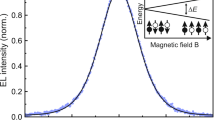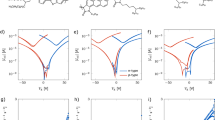Abstract
Recent advances in organic spin response include long polaron spin-coherence times measured by optically detected magnetic resonance (ODMR), substantive room-temperature magnetoelectroluminescence and magnetoconductance obtained in organic light-emitting diodes (OLEDs) and spin-polarized carrier injection from ferromagnetic electrodes in organic spin valves (OSVs). Although the hyperfine interaction (HFI) has been foreseen to have an important role in organic spin response, no clear experimental evidence has been reported so far. Using the chemical versatility advantage of the organics, we studied and compared spin responses in films, OLED and OSV devices based on π-conjugated polymers made of protonated, H-, and deuterated, D-hydrogen having a weaker HFI strength. We demonstrate that the HFI does indeed have a crucial role in all three spin responses. OLED films based on the D-polymers show substantially narrower magneto-electroluminescence and ODMR responses, and as a result of the longer spin diffusion obtained, OSV devices based on D-polymers show a substantially larger magnetoresistance.
This is a preview of subscription content, access via your institution
Access options
Subscribe to this journal
Receive 12 print issues and online access
$259.00 per year
only $21.58 per issue
Buy this article
- Purchase on Springer Link
- Instant access to full article PDF
Prices may be subject to local taxes which are calculated during checkout




Similar content being viewed by others
References
Naber, W. J. M., Faez, S. & van der Wiel, W. G. Organic spintronics. J. Phys. D 40, R205–R228 (2007).
Xiong, Z. H., Wu, D., Vardeny, Z. V. & Shi, J. Giant magnetoresistance in organic spin-valves. Nature 427, 821–824 (2004).
Ruden, P. & Smith, D. L. Theory of spin injection into conjugated organic semiconductors. J. Appl. Phys. 95, 4898–4904 (2004).
Pramanik, S. et al. Observation of extremely long spin relaxation times in an organic nanowire spin valve. Nature Nanotech. 2, 216–219 (2007).
McCamey, D. R. et al. Spin Rabi flopping in the photocurrent of a polymer light-emitting diode. Nature Mater. 7, 723–727 (2008).
Majumdar, S. et al. Application of regioregular polythiophene in spintronic devices; effect of interface. Appl. Phys. Lett. 89, 122114 (2006).
Wang, F. J., Yang, C. G., Vardeny, Z. V. & Li, X. Spin response in organic spin valves based on La2/3Sr1/3MnO3 electrodes. Phys. Rev. B 75, 245324 (2007).
Hueso, L. E. et al. Multipurpose magnetic organic hybrid devices. Adv. Mater. 19, 2639–2642 (2007).
Santos, T. S. et al. Room temperature tunnelling magnetoresistance and spin-polarized tunnelling through an organic semiconductor barrier. Phys. Rev. Lett. 98, 016601 (2007).
Tombros, N. et al. Electronic spin transport and spin precession in single graphene layers at room temperature. Nature 448, 571–575 (2007).
Dediu, V. et al. Room-temperature spintronic effects in Alq3-based hybrid devices. Phys. Rev. B 78, 115203 (2008).
Vinzelberg, H. et al. Low temperature tunnelling magnetoresistance on La2/3Sr1/3MnO3/Co junctions with organic spacer layers. J. Appl. Phys. 103, 093720 (2008).
Drew, A. J. et al. Direct measurement of the electronic spin diffusion length in a fully functional organic spin valve by low-energy muon spin rotation. Nature Mater. 8, 109–114 (2009).
Bobbert, P. A. et al. Theory for spin diffusion in disordered organic semiconductors. Phys. Rev. Lett. 102, 156604 (2009).
Pulizzi, F. Why going organic is good. Nature Mater. 8, 691 (2009).
Carrington, A. & McLachlan, A. D. Introduction to Magnetic Resonance (Harper & Row, 1967).
Yang, C. G., Ehrenfreund, E. & Vardeny, Z. V. Polaron spin-lattice relaxation time obtained from ODMR dynamics in π-conjugated polymers. Phys. Rev. Lett. 99, 157401 (2007).
Kalinowski, J. et al. Magnetic field effects on emission and current in Alq3-based electroluminescent diodes. Chem. Phys. Lett. 380, 710–715 (2003).
Mermer, Ö. et al. Large magnetoresistance in nonmagnetic π-conjugated semiconductor thin film devices. Phys. Rev. B 72, 205202 (2005).
Bobbert, P. A. et al. Bipolaron mechanism for organic magnetoresistance. Phys. Rev. Lett. 99, 216801 (2007).
Bloom, F. L., Wagemans, W., Kemerink, M. & Koopmans, B. Separating positive and negative magnetoresistance in organic semiconductor devices. Phys. Rev. Lett. 99, 257201 (2007).
Hu, B. & Wu, Y. Tuning magnetoresistance between positive and negative values in organic semiconductors. Nature Mater. 6, 985–991 (2007).
Nguyen, T. D., Sheng, Y., Rybicki, J. & Wohlgenannt, M. Magnetic field-effects in bipolar, almost hole-only and almost electron-only Alq3 devices. Phys. Rev. B 77, 235209 (2008).
Bergeson, J. D., Prigodin, V. N., Lincoln, D. M. & Epstein, A. J. Inversion of magnetoresistance in organic semiconductors. Phys. Rev. Lett. 100, 067201 (2008).
Wang, F., Bässler, H. & Vardeny, Z. V. Studies of magnetoresistance in polymer/fullerene blends. Phys. Rev. Lett. 101, 236805 (2008).
Majumdar, S. et al. Role of electron–hole pair formation in organic magnetoresistance. Phys. Rev. B 79, 201202(R) (2009).
Vardeny, Z. V., Brafman, O. & Ehrenfreund, E. Isotope effect in resonant Raman scattering and induced IR spectra of trans polyacetylene. Solid State Commun. 53, 615–620 (1985).
Weinberger, B. R. et al. Electron spin resonance studies of magnetic soliton defects in polyacetylene. J. Chem. Phys. 72, 4749–4755 (1980).
Yang, C. G., Ehrenfreund, E., Wang, F. & Vardeny, Z. V. Spin dependent kinetics of polaron pairs in organic light emitting diodes studied by ELDMR dynamics. Phys. Rev. B 78, 205312 (2008).
Abragam, A. The Principles of Nuclear Magnetism (Oxford Univ. Press, 1961).
Lupton, J. M. & Boehme, Ch. Magnetoresistance in organic semiconductors; correspondence to the Editor. Nature Mater. 7, 598–599 (2008).
Hu, B. & Wu, Y. Response to correspondence to the Editor. Nature Mater. 7, 600–601 (2008).
Bloom, F. L., Kemerink, M., Wagemans, W. & Koopmans, B. Sign inversion of magnetoresistance in space-charge limited organic devices. Phys. Rev. Lett. 103, 066601 (2009).
Groff, R. P., Suna, A., Avakian, P. & Merrifield, R. E. Magnetic hyperfine modulation of dye-sensitized delayed fluorescence in organic crystals. Phys. Rev. B 9, 2655–2660 (1974).
Timmel, C. R. et al. Effects of weak magnetic fields on free radical recombination reactions. Mol. Phys. 95, 71–89 (1998).
Hayashi, H. Introduction to Dynamic Spin Chemistry; Magnetic Field Effects on Chemical and Biochemical Reactions (World Scientific Lecture and Course Notes in Chemistry Vol. 8, World Scientific Publishing, 2004).
Weller, A., Nolting, F. & Staerk, H. A quantitative interpretation of the magnetic field effect on hyperfine-coupling-induced triplet formation from radical ion pairs. Chem. Phys. Lett. 96, 24–27 (1983).
Sheng, Y. et al. Hyperfine interaction and magnetoresistance in organic semiconductors. Phys. Rev. B 74, 045213 (2006).
Desai, P., Shakya, P., Kreouzis, T. & Gillin, W. P. Magnetoresistance in organic light-emitting diode structures under illumination. Phys. Rev. B 76, 235202 (2007).
Brocklehurst, B. & McLauchlan, K. A. Free radical mechanism for the effects of environmental electromagnetic fields on biological systems. Int. J. Radiat. Biol. 69, 3–24 (1996).
Belaid, R. et al. Magnetic field effect on recombination light in anthracene crystal. Synth. Metals 131, 23–30 (2002).
Fert, A. Nobel Lecture: Origin, development, and future of spintronics. Rev. Mod. Phys. 80, 1517–1530 (2008).
Dediu, V. A., Hueso, L. E., Bergenti, I. & Taliani, C. Spin routes in organic semiconductors. Nature Mater. 8, 707–716 (2009).
Jullière, M. Tunneling between ferromagnetic films. Phys. Lett. A 54, 225–226 (1975).
Zhang, J. & White, R. M. Voltage dependence of magnetoresistance in spin dependent tunnelling junctions. J. Appl. Phys. 83, 6512–6514 (1998).
Sheng, L., Xing, D. Y. & Sheng, D. N. Theory of the zero-bias anomaly in magnetic tunnel junction. Phys. Rev. B 70, 094416 (2004).
Rolfe, N. J. et al. Elucidating the role of HFI on organic MR using deuterated Alq3 . Phys. Rev. B 80, 241201 (2009).
Acknowledgements
We thank R. Polson for the Raman scattering measurements of the two polymers, and M. Wohlgenannt for useful discussions. This work was supported in part by the Department of Energy (Grant No. 04-ER46109; Z.V.V.), the NSFC and National Basic Research Program of China (Grant 2009CB929502; X-G.L.) and the Israel Science Foundation (ISF 745/08; E.E.). Z.V.V. wishes to thank the Lady Davis foundation for helping his stay at the Technion during spring 2009, where part of the present work was conceived.
Author information
Authors and Affiliations
Contributions
T.D.N. was responsible for the OLED and OSV device fabrication and measurements; G.H-M. was responsible for the ODMR measurements; F.W. was responsible for the MFE and OSV system apparatus and magneto-optic Kerr effect measurements; L.W. was responsible for the synthesis of the D- and H- polymers; X-G.L. was responsible for growing the LSMO substrates; E.E. was responsible for the ODMR and MEL analysis and model fittings; Z.V.V. was responsible for project planning, group managing and first draft writing.
Corresponding author
Ethics declarations
Competing interests
The authors declare no competing financial interests.
Supplementary information
Supplementary Information
Supplementary Information (PDF 543 kb)
Rights and permissions
About this article
Cite this article
Nguyen, T., Hukic-Markosian, G., Wang, F. et al. Isotope effect in spin response of π-conjugated polymer films and devices. Nature Mater 9, 345–352 (2010). https://doi.org/10.1038/nmat2633
Received:
Accepted:
Published:
Issue Date:
DOI: https://doi.org/10.1038/nmat2633
This article is cited by
-
Molecular design for enhanced spin transport in molecular semiconductors
Nano Research (2023)
-
Synthesis and Study of Reactive Mesogen in a Spin Valve Structure
Journal of Superconductivity and Novel Magnetism (2023)
-
Singlet and triplet to doublet energy transfer: improving organic light-emitting diodes with radicals
Nature Communications (2022)
-
Stereodefined rhodium-catalysed 1,4-H/D delivery for modular syntheses and deuterium integration
Nature Catalysis (2021)
-
Floquet spin states in OLEDs
Nature Communications (2021)



